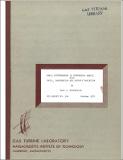Small disturbances in compressor annuli with swirl, throughflow and entropy variation
Author(s)
Kerrebrock, Jack L.
Download09673726.pdf (1.243Mb)
Other Contributors
Massachusetts Institute of Technology. Gas Turbine Laboratory
Metadata
Show full item recordAbstract
Introduction: Control of the radiation of sound from the compressors and turbines of jet engines depends to a great extent on understanding of the propagation of acoustical modes in the ducting, the general design approach being to choose the numbers of blades in interacting rows so that no propagating mode will be strongly excited. The conditions for non-propagation or "cutoff" are therefore critical to this procedure. Another application of modal analysis is found in the linear three dimensional flow theory of turbomachinery. Here the complete isentropic flow field of the compressor rotor is represented as a superposition of normal modes. To date, most such modal treatments have either neglected the effect of average flow velocity in the turbomachine duct, or considered the acoustical disturbances to propagate in a gas at rest in a coordinate system moving with the average flow velocity. This approach is correct if the resulting (moving) coordinate system is inertial, but in general is not correct for rotating coordinate systems. In the context of compressor analyses, it is valid for uniform axial flow, as applied by McCune, for example, but incorrect for swirl, as applied by Morfey.Indeed, as we shall show, the classical technique of dividing small disturbances into the three classes of vorticity, entropy, and sound fluctuations, which do not interact to first order, is not valid in rotating flows. Thus, a generalization of the concepts of sound and turbulence is needea. Such a generalization will not be achieved in the present work, but it is hoped that a few steps will be made in this direction. The general equations for pressure disturbances in an inhomogeneous swirling gas have been given by Blokhintsev, who also obtained the general equation for an isentropic gas. Apparently the only other analyses of pressure wave behavior in rotating fluids are those of Salant and Sozou. The former considered the effects of a solid body rotation on the symmetric normal modes, i.e., modes with no tangential nonuniformity. The latter treated the same type of disturbance in a Rankine vortex. The main purpose of the present analysis is to provide a consistent modal acoustic treatment for compressor annuli with large swirl and throughflow, and with radial variations of entropy. The mean flow will be assumed uniform in the axial and tangential directions, so that the results are applicable only sufficiently far upstream and downstream of blading that the first order variations in these directions have died out. As might be expected, the analysis is nevertheless somewhat complex. While a general treatment will be given, for arbitrary radial variations of entropy and tangential and axial velocity, analytical solutions for the radial eigenfunctions are available only for some special cases. These do include three important cases, namely, 1) isentropic flow with solid body rotation and constant axial velocity, 2) isentropic flow with free vortex rotation and constant axial velocity, and 3) flow with negligible mean velocity but with radial entropy variation. The first of these represents the conditions behind inlet guide vanes, though not with complete consistency, as will be noted below. The second represents quite accurately the conditions behind high-work fan rotors, except for the effects of entropy variation. The last case gives some insight into the effects of such variations.
Description
October 1970 Includes bibliographical references (leaf 25)
Date issued
1970Publisher
Cambridge, Mass. : Gas Turbine Laboratory , Massachusetts Institute of Technology, [1970]
Series/Report no.
GTL report #104